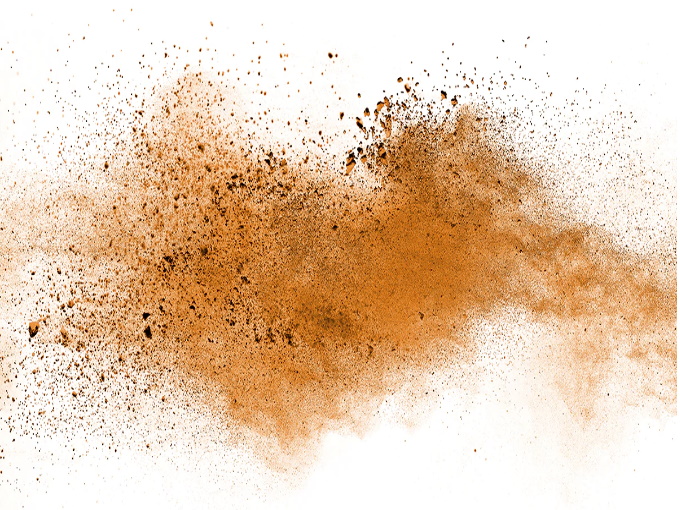
The European Centre of the Foundation for Allergy Research predicts that one in two babies born in Europe in 2020 will develop an allergy throughout their lives. There are several theories as to why this happens, but it is clear that the way we design the spaces we inhabit and work in has something to do with it. We analyze how to make them safe and healthy places.
- What can we do at home?
Although we usually relate allergies to spring and pollen, let’s not forget that 90% of the time is spent indoors, and therefore we have to pay close attention to the allergen foci in our own home. These particles can come from the construction materials themselves, so we must control their composition and origin, especially in the finishes. Also from the outside, so it will be convenient to control the air renewal systems of the house. Or we may generate them ourselves with our daily habits of hygiene, beauty or cleaning.
- What is an allergy?
In essence, an allergy is an overreaction of our immune system to an external agent. These agents can come into contact with us through touch, ingestion or breathing fundamentally. In homes, it is a priority to control air quality because most reactions occur due to the inhalation of certain particles.
- Are we more allergic?
Everything indicates that we are increasingly allergic to the direct effect of the various environmental factors that have been modified over time in our industrialized world. Exposure to chemically altered compounds, air pollution, food additives or chemical compounds present in clothing or perfumes press our body purification system to induce the allergic reaction.
- Invisible allergies
Diseases such as Multiple Chemical Sensitivity (MCS) or electro sensitivity manifest themselves in a very similar way to allergies: our immune system reacts to what it interprets as aggression. The difference is that, in this case, they can have their origin in architectural elements or installations: chemical compounds of almost any type in the case of MCS or emitters of electromagnetic waves such as telephone antennas or wireless networks (wifi) in the second.
- Body filters
When the multiple biological purification systems – liver, kidneys, lungs – are permanently exposed to high levels of demand, we run the risk of them saturating; it will depend on genetic predisposition and lifestyle habits. If you imagine them as an air filter, you will understand the concept of saturation. The difference is that ours cannot be replaced.
- Materials and facilities
Architecture cannot affect genetic parameters or habits. In a design we have, in essence, two work areas on which to act to guarantee a healthy and innocuous environment: on the one hand, the materials with which we build, paying special attention to the interior coatings of the spaces, and, on the other, the facilities that we incorporate into the house.
- Dust mites
We usually associate allergies to dust, although what we really react to is the mites that are in it. To help people sensitive to mites, it is advisable to reduce textile coatings such as carpets, carpets, curtains or fabrics on furniture and beds. These materials accumulate dust on their porous surface more easily.
- Avoid porosity
In situations of maximum sensitivity, porous materials should even be replaced by melamines, vitrified surfaces or even stainless steels. These types of materials are the most used in hospital environments due to their ease of cleaning and the difficulty of proliferation for any microorganism.
- Water-based varnishes
When we talk about varnishes we enter the world of chemical agents, another trigger for the reactions of the immune system that does not fall within the common definition of allergy. The function of varnish is precisely to seal the pore of the wood to reduce allergens in the environment. Water-based varnishes do not emit toxic substances.
- Hormone disruptors
Many chemical agents that trigger immune system reactions are called hormone or endocrine disruptors. Our body identifies them as hormones and, when detected, triggers biological reactions out of context. It is just as important to control them to ensure a safe environment.
- Trust seals
Some of these compounds are very defined and controlled, but despite everything we have to live with them because there are no regulations that prohibit them. Look for quality seals that tell you which products reduce them to the maximum or eliminate them: VOC Free, Blue Angel, “Indoor Air Emissions Label”, etc.
- Mold spores
Another common allergen is mold spores. In a poorly insulated and poorly ventilated house with organic-based materials (such as plastic paint), the appearance of moisture and mold is almost guaranteed, and with it the spores, tiny particles that the mold releases into the environment and we inhale automatically.
- Mineral-based paints
Paints can represent about 70% of the interior surface of a home. Perhaps one of the decisions with the greatest positive impact for people with multiple chemical sensitivity or mold allergy is to opt for mineral-based paints. Plastic paint is synthetic organically based, which serves as food for mold in case there is permanent presence of water on the surface. Mineral paints, on the other hand, tend to reduce or eliminate VOCs and formaldehydes in their composition. There are mostly lime, silicate, clay or graphene.
- Humidity at its right point
Relative humidity (RH) is the amount of water present in the air. Ideally it should always be between 40% and 60%. When the RH is too high, the evaporation of water is slow and causes condensation problems and, consequently, the appearance of moldis much more likely. In addition, it usually does it in dark places, where it will be difficult for you to detect it.
- Harmful dryness
If the HR is low, other totally different problems appear, but also associated with allergies, such as the fact of favoring a greater levitation of dust in the air, which is why people allergic to mites will see their reaction increased. It also increases colds, dries out mucous membranes and skin, promotes eye inflammation and asthma, among other conditions.
- Ventilation systems
For homes where people sensitive to any type of allergy or reaction related to the inhalation of particles live, the best solution will be to control the air quality mechanically. First, we will guarantee the tightness by installing quality windows and very well defined construction details, and then we will install a filtered and automated air renewal system.
- Activated carbon filter
These air renewal systems are usually complemented by air handling filters; the most common are particle blocking powders which are classified as follows: coarse (G1, G2, G3 and G4), medium (M5 and M6) and fine (F7, F8 and F9) powders. There is also a much more extreme classification; it is the one used in hospitals and laboratories; it is not usually necessary in homes.
- Other air treatments
In addition to common filters, these systems are complemented by relative humidity regulators, CO2 detectors, heat recovery systems, biocides or air ionizers. The complexity they can achieve is very high, until they achieve practically pure air, ideal for people with chronic respiratory problems or multiple chemical sensitivity.
- Renew vs Boost
In the field of air conditioning, it is necessary to differentiate air renewal, with very low flows, from air conditioning systems driven by air. The latter have the disadvantage that their high flow usually removes dust from the house and can become a real problem for people allergic to mites.
- Radiation climate
The most appropriate air conditioning system to guarantee a less allergic home is the radiation system. The heat radiated by the system, whether from the floor, walls or ceiling, travels through waves without altering either temperature or humidity and without removing the air. What heats up is the matter in the house, not the air you breathe.
- Decorative “Noise”
Once a house is built that pretends to be “anti-allergy” it will be necessary to acquire habits that do not harm this characteristic. One of them will have a lot to do with decoration. It is clear that an environment overloaded with decorative objects is an invitation to the accumulation of dust unless proper cleaning is done.
- Vacuum with water filter
Despite all the precautions described, dust will still exist in the dwelling; in fact it is inevitable: the inhabitants are the main producers of dust. Vacuuming it is the fastest way to remove it. To prevent some of the dust from returning to the room and removing the air, it is better if you do it with a vacuum cleaner with a water filter.
- Allergen carriers
Those of us who are dedicated to the analysis and design of healthy architecture find too often that, after all the efforts made, the users of the houses themselves are the first to create harmful environmental conditions, either due to ignorance or recklessness.
- Cleaning products
The main sources of toxic particles in the indoor environment are cleaning products. The labels of these products themselves already warn of their dangerous composition. Its toxicity is also reinforced by the particles released by other household products such as cosmetics or laundry detergents.
- Conclusion
A house capable of eradicating all types of allergic reactions requires the involvement and knowledge of the professional who designs it and the commitment of the user. It is not surprising that seals of quality and sustainability in construction such as LEED or BREEAM place so much emphasis on the management of the building once finished to ensure precisely that the impact on the environment and the health of the people who use it is almost zero for as long as possible.
MSN News – Rafael Hernandez
NB: Some images retrieved from Google, will remove at owner’s request.
